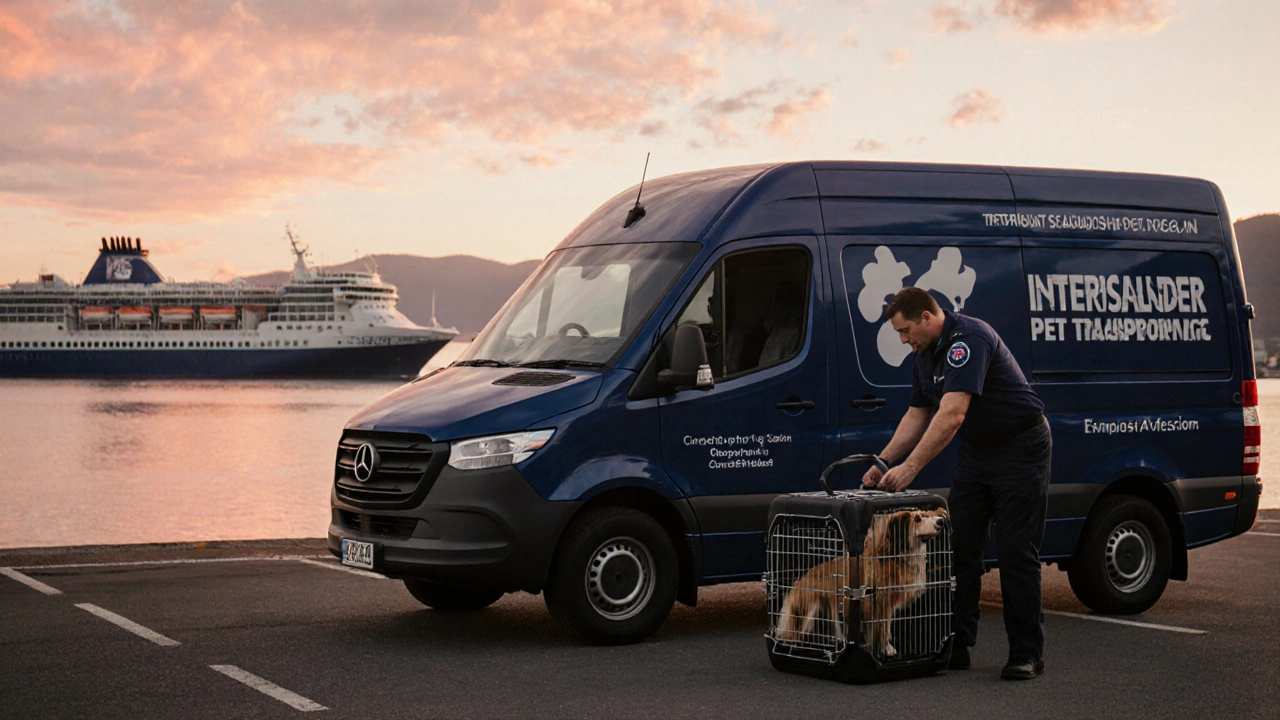Pet Travel Cost Calculator
Compare Pet Travel Costs
Estimate costs for your next pet move based on distance, pet size, and travel method
Estimated Cost Range
Flights with pets are stressful - for you and your animal. Airlines have strict rules, extra fees, and limited space. Even if your pet is small enough for the cabin, the noise, pressure changes, and confinement can scare them. And if they’re too big? You’re looking at cargo hold risks, long delays, and paperwork that feels like a maze. But you still need to move - whether it’s for work, family, or a new home. So what can you do instead of flying with your pet?
Drive Instead - It’s Simpler Than You Think
Driving is the most common and safest alternative to flying with your pet. In New Zealand, you can drive from Auckland to Wellington in under seven hours, or to Christchurch in just over 10. That’s less time than most airport check-ins take. Pets handle car rides better than planes, especially if they’re used to short trips.
Plan your route with pet-friendly stops. Use apps like PetFriendly or BringFido to find rest areas with water bowls, dog parks, or even pet hotels. Pack a travel kit: leash, collapsible bowl, familiar blanket, and enough food for the trip plus two extra days. Never leave your pet alone in the car - even with windows cracked, temperatures can spike dangerously fast.
Most pets adapt quickly. One dog owner from Tauranga drove 1,200 km to join her family in Queenstown. Her 8-year-old Labrador, Max, slept through most of it. She says, “I didn’t realize how much easier it was until I tried it.”
Use a Professional Pet Transport Service
If you can’t drive yourself - maybe you’re relocating overseas or your schedule is packed - hire a professional pet transport company. These services specialize in moving animals safely by road, rail, or even sea. In New Zealand, companies like PetRelocation NZ and Animal Transport Solutions handle everything: vet paperwork, customs, climate-controlled vehicles, and door-to-door delivery.
They don’t just move dogs and cats. They’ve transported rabbits, birds, and even reptiles. Costs vary based on distance and pet size. A domestic move from Auckland to Dunedin might cost $500-$800. International moves start around $2,500. But compared to airline cargo fees, pet stress, and potential delays, it’s often worth it.
Look for companies accredited by the International Pet and Animal Transportation Association (IPATA). They follow strict safety standards, including temperature controls, regular check-ins, and trained handlers. Always ask for references and a detailed itinerary before booking.
Send Your Pet by Rail or Ferry
Some countries offer pet-friendly rail services. In New Zealand, KiwiRail doesn’t allow pets on passenger trains - but you can ship them as cargo through their Freight Services. It’s not common, but it’s an option for long-distance moves within the country. Pets travel in climate-controlled vans, tracked like parcels, and delivered to major stations.
Ferries are another quiet alternative. The Interislander ferry between Wellington and Picton allows pets on board in the vehicle or in designated pet areas. You can walk your dog during the 3.5-hour crossing. Many pet owners choose this route when moving between the North and South Islands. It’s cheaper than flying, less stressful than cargo, and you get to see the Marlborough Sounds with your pup by your side.

Board or Pet-Sit While You Travel
Not every trip needs your pet to come along. If you’re going away for a week or two - maybe a work conference or a short vacation - consider leaving them behind with a trusted sitter or boarding facility.
Modern pet boarding isn’t what it used to be. Places like Happy Paws Retreat in Auckland offer private suites, daily walks, video updates, and even grooming. Some even have cat playrooms with climbing towers and bird-safe windows. Prices range from $30-$60 per night, depending on amenities.
Alternatively, hire a professional pet sitter. Services like Pawshake or Wag! connect you with local sitters who come to your home. Your pet stays in their own space, eats their own food, and follows their routine. This reduces anxiety significantly. One cat owner in Napier left her 14-year-old Persian with a sitter while she flew to Australia for her sister’s wedding. “She didn’t meow once after I came back,” she said. “That’s how calm she was.”
Try a Pet-Friendly Cruise or Train Tour
Some international cruise lines allow pets on select routes. Cunard’s Queen Mary 2 is one of the few that accepts dogs on transatlantic crossings. Pets stay in a dedicated kennel area with daily walks and care from trained staff. It’s expensive - around $1,500 for a 7-day trip - but it’s a unique way to travel with your dog without the stress of air travel.
Train tours in Europe and North America also offer pet-friendly options. The Rocky Mountaineer in Canada allows small dogs in certain cabins. You travel during the day, stop at scenic spots, and your pet gets to stretch their legs. These aren’t available in New Zealand yet, but they’re worth researching if you’re planning an overseas move.

Prepare for the Long-Term: Build Pet Travel Confidence
If you know you’ll need to move again - maybe for work or family reasons - start preparing now. Train your pet for car rides. Start with short trips to the park. Gradually increase the time. Use treats and praise to make the car a positive place.
Get your pet used to their carrier or crate. Leave it open at home with a cozy bed inside. Feed meals near it. Let them explore it on their own. This reduces panic during actual travel.
Also, make sure your pet’s ID is up to date. Microchip with current contact info. Wear a collar with your phone number. If you’re using a transport service, ask for a tracking number and check-in schedule. Most reputable companies send updates every 4-6 hours.
What Not to Do
Don’t sedate your pet for travel. Veterinarians in New Zealand and most countries strongly advise against it. Sedatives can interfere with breathing, especially at altitude or in hot cargo holds. They can also mask signs of distress.
Don’t rely on online forums for advice. Every airline, state, and country has different rules. What works in Australia might get your pet turned away in Japan. Always check official sources: the Ministry for Primary Industries (MPI) in New Zealand, the USDA in the US, or the EU’s Pet Travel Scheme.
And never try to sneak your pet onto a flight as a “service animal” if they’re not trained. Airlines now require documentation, and fake service animals are being caught more often. You risk fines, delays, and your pet being denied entry.
Final Thoughts: There’s Always a Better Way
Flying with your pet isn’t the only option - and often, it’s not the best. Driving gives you control. Professional transport gives you peace of mind. Boarding or pet-sitting lets your pet stay safe at home. Ferries and trains offer calm, scenic alternatives.
Think about your pet’s personality. A nervous cat might do better with a sitter. A high-energy dog might love a road trip with frequent stops. A senior pet might need the comfort of home. There’s no one-size-fits-all solution. But there are plenty of good ones.
Plan ahead. Talk to your vet. Research your options. Your pet deserves a trip that’s as safe and comfortable as yours.
Can I take my pet on a domestic flight in New Zealand without cargo?
Yes, but only if your pet is a small dog or cat and fits in an approved carrier under the seat. Airlines like Air New Zealand allow this on most domestic routes, but space is limited. You’ll need to book in advance, pay a fee (around $100-$150), and provide proof of vaccinations. Always check the airline’s current pet policy before booking.
How much does it cost to ship a pet within New Zealand?
Domestic pet transport within New Zealand typically costs between $400 and $1,200, depending on distance, pet size, and service level. Door-to-door services with climate control and tracking usually start at $600 for a medium-sized dog from Auckland to Christchurch. Smaller pets or basic drop-off services can be cheaper. Always get multiple quotes.
Is it safe to fly my pet as cargo?
It carries risks. Cargo holds aren’t always climate-controlled, and delays can happen. According to the U.S. Department of Transportation, over 30 pet deaths were reported on U.S. flights in 2024 alone - mostly due to heat stress or rough handling. While some airlines have better records than others, even the safest cargo flights are stressful for pets. It’s best avoided unless absolutely necessary.
What documents do I need to move my pet within New Zealand?
For domestic travel, you need a current veterinary health certificate (issued within 10 days of travel) and proof of rabies vaccination. If your pet is microchipped, make sure the registration is up to date. Some transport companies or boarding facilities may also require proof of flea and tick treatment. Always carry a copy of your pet’s medical records.
Can I take my pet on a ferry between the North and South Islands?
Yes. The Interislander ferry between Wellington and Picton allows pets. You can keep your pet in your vehicle during the crossing, or use the designated pet area on deck (leashed and supervised). There’s no extra charge if you’re traveling with your car. If you’re on foot, there’s a small fee (around $25). Book ahead - pet spots fill up quickly during holidays.
What if my pet gets anxious during travel?
Try calming aids like pheromone sprays (Adaptil for dogs, Feliway for cats), anxiety wraps (Thundershirts), or natural supplements like L-theanine or chamomile - but only after checking with your vet. Never use human sedatives. Practice short trips beforehand. Bring familiar items: a blanket with your scent, their favorite toy. Keep the environment calm - avoid loud music or sudden movements.
